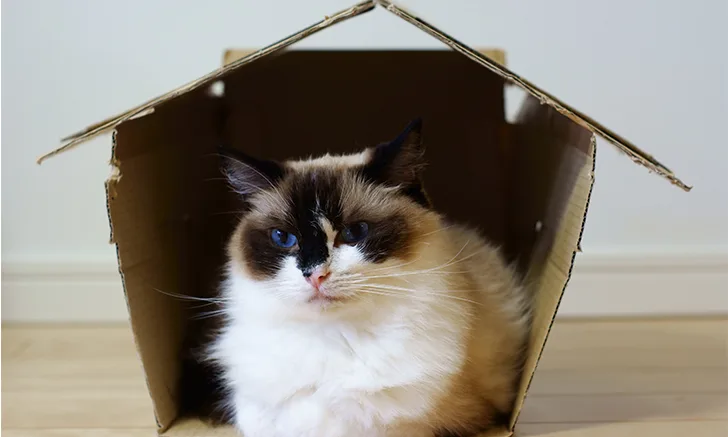Long-Term Management of Feline Idiopathic Cystitis
Kelly A. St. Denis, MSc, DVM, DABVP (Feline Practice), Charing Cross Cat Clinic, Brantford, Ontario

Sponsored by Hill’s Pet Nutrition, Inc.
Murphy, a 2-year-old, neutered male ragdoll cat, had been recently purchased and was living in a home with 2 adults and one other ragdoll cat. Murphy did not exhibit the relaxed, cuddly nature typical of his breed; instead, he was nervous and jumpy and disliked being handled.
History
Murphy was presented to the clinic with lower urinary tract signs (LUTS) including periuria and dysuria. He was not obstructed, and other than microscopic hematuria, diagnostic test results (ie, blood work, urinalysis, radiography) were normal. Murphy responded well to treatment with analgesics, and his episode of LUTS quickly resolved.
Presentation
Murphy was returned for recurrence of signs 1 week later. Even before recurrence of clinical signs, it was recognized Murphy would likely experience this problem again; he fit all the criteria of a cat with feline idiopathic cystitis (FIC).
Diagnosis
FIC accounts for more than 60% of causes for LUTS.1 Clinical signs of FIC may include hematuria, periuria, dysuria, stranguria, and/or pollakiuria, which can be complicated by urinary tract obstruction in males. Causes of FIC are not clearly understood, and contributing factors are numerous. Inflammatory changes in the bladder wall are associated with FIC. Stress is considered a major contributing factor, with FIC patients often exhibiting recurrence of clinical signs when exposed to presumably stressful, unusual external events.2-5
Management
When managing cats with LUTS in general, and FIC in particular, 3 clear factors emerge:
Feeding a high-quality, therapeutic food can help manage LUTS cases via reduction of recurrence of FIC signs as well as reduce the risk of struvite and calcium-oxalate formation.6-7
Stressors in patient care and environment should be identified and managed.8
Prevention, reduction, and overall control of inflammatory pathways should be targeted to reduce recurrence and associated clinical signs.6
Murphy’s food, environment, and lifestyle were discussed with the owners, particularly situations that encouraged anxiety or calmness. Murphy’s environment required several adjustments: As Murphy lived with other cats, it was necessary to ensure ample resources (eg, litter boxes, food bowls, water stations, resting spots, play structures, toys) were available to reduce anxiety. The owners were advised to institute a regular daily schedule of feeding times, litter box care, and client-directed play time. Anxiety levels were high enough that fluoxetine was prescribed.
A food change was recommended to reduce Murphy’s risk for recurrence of signs associated with FIC as well as reducing the risk for other causes for LUTS such as urolithiasis. The recommended food, Hill’s® Prescription Diet® c/d® Multicare Feline, was selected based on evidence supporting a clinically significant reduction of FIC signs (See Nutritional Management of FIC). The owners chose the wet variety of the product based on their cat’s preference and received the vet’s permission to feed it to the remaining cats in their household as well.
Outcome
Murphy responded well to the food change and has continued on the food for more than 2 years. With the change of the food, environmental enrichment, and appropriate resource management, Murphy’s episodes of periuria decreased, and he has not had any episodes of dysuria or hematuria. He has continued to require fluoxetine to minimize the periuria.
Nutritional Management of FIC
In a randomized, double-blinded, prospective study, researchers assigned cats with FIC to foods with 2 different nutritional profiles and followed them for one year.6 During that time, owners documented any clinical signs associated with LUTS and FIC recurrence. An episode was defined as 2 or more LUTS occurring on consecutive days.
The test food was Hill’s® Prescription Diet® c/d® Multicare Feline wet or dry. This food features a modest reduction in mineral content and produces a more acidic urinary pH. For anti-inflammatory purposes, the food contains higher concentrations of antioxidants vitamin E and ß-carotene and increased concentrations of omega-3 fatty acids.
The control food was a custom manufactured food formulated to meet or exceed the Association of American Feed Control Officials requirements for adult cats, with mineral concentrations designed to mimic commercial feline maintenance foods and had a targeted neutral urinary pH.
Results of the study showed that cats fed the test food, Hills® Prescription Diet® c/d® Multicare, had an 89% reduction in recurrent episodes of hematuria, dysuria, and/or stranguria.
